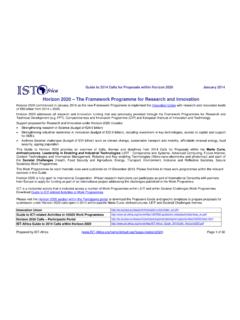Transcription of The Opportunities and Challenges of FDI in Retail in India
1 IOSR Journal Of Humanities And Social Science (JHSS). ISSN: 2279-0837, ISBN: 2279-0845. Volume 5, Issue 5 (Nov. - Dec. 2012), PP 99-109. The Opportunities and Challenges of FDI in Retail in India Rajib Bhattacharyya Assistant Prof. in Economics, P. G. Department of Commerce, Hooghly Mohsin College, India Abstract: The spectacular and unprecedented growth of FDI in the global economic landscape over the last two decades has made it an integral part of the development strategy of both the developed and developing nations. It acts as a major catalyst in the development of a country through up-gradation of technology, managerial skills and capabilities in various sectors. Rise in purchasing power, growing consumerism and brand proliferation has led to Retail modernization in India . The growing Indian market has attracted a number of foreign retailers and domestic corporate to invest in this sector.
2 FDI in the Retail can expand markets by reducing transaction and transformation costs of business through adoption of advanced supply chain and benefit consumers and suppliers (farmers). Oppositions have raised concerns about employment losses, promotion of unhealthy competition among organized domestic retailers resulting in exit of small domestic retailers from the market and distortion of urban cultural development. The present paper focuses on the overview of the Indian Retail sector along with the Opportunities of expansion of FDI in Retail in India and the major Challenges that it faces. Key Words: FDI, Indian Retail sector, Opportunities and Challenges , Impact on Stakeholders. I. Introduction Widespread liberalization and deregulation of financial markets, cross-border mergers and acquisitions (M&As), increasing role of investors willing to invest abroad, rapid advances in modern telecommunication and computer network have all resulted in a tremendous upsurge of international capital flows in India , particularly private capital flows, as compared to official capital flows over the last two decades.
3 Among the various forms of foreign investment, foreign direct investment (FDI) flows are usually preferred over other forms of external finance because they are non-debt creating, non-volatile and their returns depends on the performance of projects financed by the investors. In fact, FDI provides a win win situation to both the host and the home countries. The home countries want to take the advantage of the vast markets opened by industrial growth. On the other hand the host countries want to acquire technological and managerial skills and supplement domestic savings and foreign exchange. Moreover, in order to overcome the deficiencies of all kinds of resources viz. financial, capital, entrepreneurship, technological know- how, skills and practices, access to markets-abroad - in their economic development, developing nations accepted FDI as a sole visible panacea for all their scarcities.
4 Economic development, rise in purchasing power, growing consumerism and brand proliferation has led to Retail modernization in India . With high economic growth, per capita income increases; this, in turn, leads to a shift in consumption pattern from necessity items to discretionary consumption. Furthermore, as the economy liberalizes and globalizes, various international brands enter the domestic market. Consumer awareness increases and consumers tend to experiment with different international brands. The proliferation of brands leads to increase in Retail space. Retail modernization in India depicts a similar story. According to Kearney s Annual Global Retail Development Index (GRDI) for the year 2012, India has been placed at fifth rank (after Brazil, Chile, China and Uruguay) on the basis of Retail investment attractiveness.
5 The growing Indian market has attracted a number of foreign retailers and domestic corporate to invest in this sector. Being encouraged by India s growing Retail boom many multinational companies also started to enter India s Retail market. According to the Investment Commission of India , the Retail sector is expected to grow almost three times its current levels to $660 billion by 2015. FDI in the Retail sector can expand markets by reducing transaction and transformation costs of business through adoption of advanced supply chain and benefit consumers, and suppliers (farmers). Opposition to liberalizing FDI in this sector raises concerns about employment losses, promotion of unhealthy competition among organized domestic retailers resulting in exit of small domestic retailers from the market and distortion of urban cultural development.
6 II. Objective Of The Study And Methodology The objective of our study is to analyze the current Retail scenario in India , investigate the controversial views of the various stakeholders and evaluate the likely Challenges and threats of FDI in both single and multi- brand Retail in India . The whole paper is based on descriptive arguments, statistical data, case studies, 99 | Page The Opportunities and Challenges of FDI in Retail in India comparative study and analytical logic developed through the understandings from various research papers, reports, books, journals, newspapers and online data bases. III. Indian Retail Sector: An Overview And Current Position Meaning of Retail It is defined as all activities involved in selling goods or services directly to the final consumer for their personal, non-business use via shops, market, door-to-door selling, and mail-order or over the internet where the buyer intends to consume the product.
7 In 2004, The High Court of Delhi defined the term Retail as a sale for final consumption in contrast to a sale for further sale or processing. Retailing involves a direct interface with the customer and the coordination of business activities from end to end- right from the concept or design stage of a product or offering, to its delivery and post-delivery service to the customer. Evolution of Indian Retail Industry It is interesting to focus on the evolution of the Retail sector in India . Historically they evolved as a source of entertainment (in the form of village fairs, melas etc.) which was within the rural reach. Later on these were transformed Mom and Pop/ Kirana stores which are of traditional variety neighbourhood shops. Then came the government supported PDS outlets, khadi stores, cooperatives etc. Finally shopping malls, supermarkets, departmental stores etc has brought a great revolution to the Indian Retail market (figure-1).
8 Figure- (1). Source: Technopak Research Distinction of Indian Retail The Indian trading sector, as it has developed over centuries, is very different from that of the developed countries. In the developed countries, products and services normally reach consumers from the manufacturer/producers through two different channels: (a) via independent retailers ( vertical separation ) and (b) directly from the producer ( vertical integration ). In India , however, the above two modes of operation are not very common. Small and medium enterprises dominate the Indian Retail scene. The trading sector is highly fragmented, with a large number of intermediaries. So also, wholesale trade in India is marked by the presence of thousands of small commission agents, stockiest and distributors who operate at a strictly local level. Retail giants like US-based Wal-Mart and French Carrefour are very keen to enter in the segment.
9 Bharti Enterprises and Wal-Mart Stores entered into a joint venture in August 2007 and started cash-and-carry stores named 'Best Price Modern Wholesale' in 2009. Division of Indian Retail Industry The Indian Retail industry is generally divided into two major segments organized retailing and unorganized retailing. (a) Organized Retailing - refers to trading activities undertaken by licensed retailers, that is, those who are registered for sales tax, income tax, etc. These include the corporate-backed hypermarkets and Retail chains, and also the privately owned large Retail businesses. (b) Unorganized Retailing - refers to the traditional formats of low-cost retailing, for example, the local kirana shops, owner manned general stores, paan/beedi shops, convenience stores, hand cart and pavement vendors, etc. 100 | Page The Opportunities and Challenges of FDI in Retail in India Table-1.
10 Share of Organized Retail in Selected Countries, 2006. Source: Planet Retail and Technopak Advisers Pvt. Ltd. In the developed economies, organized Retail is in the range of 75-80 per cent of total Retail , whereas in developing economies, the unorganized sector dominates the Retail business. The share of organized Retail varies widely from just one per cent in Pakistan and 4 per cent in India to 36 per cent in Brazil and 55 per cent in Malaysia (Table-1). Modern Retail formats, such as hypermarkets, superstores, supermarkets, discount and convenience stores are widely present in the developed world, whereas such forms of Retail outlets have only just begun to spread to developing countries in recent years. In developing countries, the retailing business continues to be dominated by family-run neighbourhood shops and open markets.
















